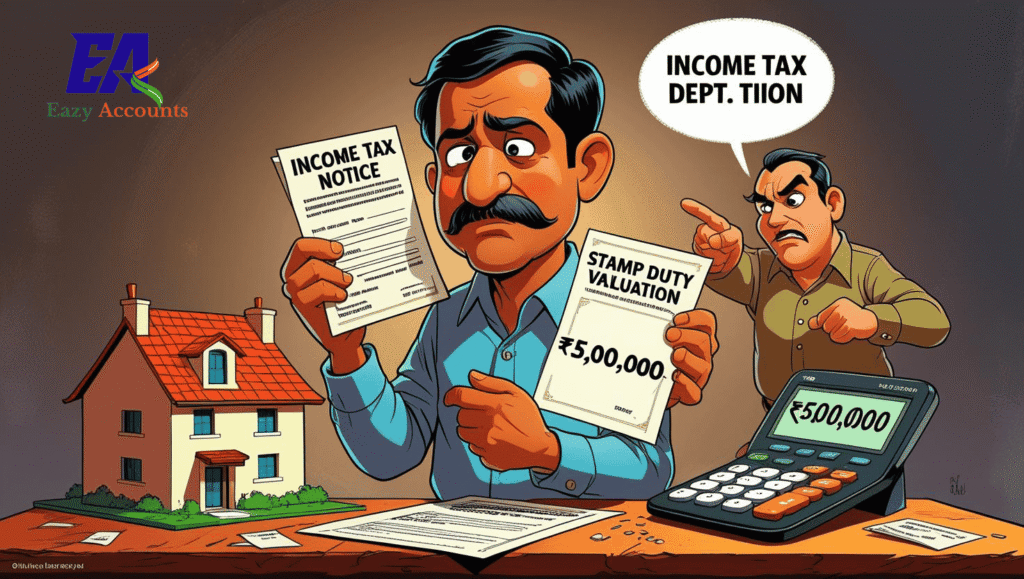Recently, many taxpayers have received notices from the Income Tax Department under Section 56(2)(x) of the Income Tax Act. Why? Because they bought property at a price lower than the stamp duty value (SDV) — often with genuine reasons.
Maybe the seller was in distress.
Maybe the market price didn’t match the stamp authority’s “optimism.”
Maybe there was a new mall or metro line inflating values on paper — but not in reality.
Still, the tax department says:
If the stamp duty value is too much higher than your purchase price — we’ll tax the difference like a gift.

Let’s understand how.
What exactly [Section 56(2)(x)(b)(B)] says
Where any person receives any immovable property for a consideration, and the stamp duty value of such property exceeds such consideration,
and the amount of such excess is more than the higher of ₹50,000 or 10% of consideration,
then such excess shall be charged to income-tax under the head “Income from Other Sources”.
The Deal That Brings Tax Trouble
Imagine this:
You buy a property for ₹50 lakhs.
Stamp Duty Value (SDV) of that same property? ₹1 crore.
You think: “Great deal!”
The seller thinks: “At least I sold it.”
But the Income Tax Department thinks: “You just got a ₹50 lakh gift.”
And that’s where Section 56(2)(x) of the Income Tax Act steps in and says:
If any person receives immovable property for less than the stamp duty value, and the difference is:
- More than ₹50,000 and
- More than 10% of the consideration paid
Then the difference is taxable as “Income from Other Sources.”
When Exactly Does This Section Apply?
This tax trap gets triggered only when all these conditions are met:
Conditions for Applicability:
- You are the buyer of an immovable property (land or building).
- You paid less than the stamp duty value (SDV).
- The difference between SDV and your purchase price is:
- More than ₹50,000, and
- More than 10% of the price you paid.
If both of these conditions are true — tax applies.
See the following table to understand better:
| Particulars | Case A | Case B |
|---|---|---|
| Stamp Duty Value (SDV) | ₹55,00,000 | ₹1,00,00,000 |
| Purchase Price (Actual Value) | ₹50,00,000 | ₹70,00,000 |
| Difference | ₹5,00,000 | ₹30,00,000 |
| 10% of Purchase Price | ₹5,00,000 | ₹7,00,000 |
| Is Difference > ₹50,000? | ✅ Yes | ✅ Yes |
| Is Difference > 10% of Price Paid? | ❌ No (Equal) | ✅ Yes |
| Is Section 56(2)(x) Applicable? | ❌ No Tax | ✅ Yes – ₹30L Taxable |
What If the Price Was Low for a Reason?
This is where reality and tax law clash.
Maybe the seller was:
- In financial trouble (distress sale)
- Selling an old house in a newly developing area
- Under legal dispute or trying to close an urgent deal
But unfortunately: The Income Tax Act doesn’t care “why” you paid less. It just compares numbers.
Even if the lower price is 100% genuine, the tax still applies — unless you’re covered under an exemption.
Who Gets Taxed? (Both Buyer & Seller!)
This is a double-edged sword:
For the Buyer:
- The difference between SDV and your purchase price is taxed under “Income from Other Sources” [Section 56(2)(x) of the Income Tax Act].
- You pay tax at slab rate — even if you had no hidden gain.
For the Seller:
- Under Section 50C, the seller’s capital gains are calculated based on SDV, not the sale price.
- So they end up paying capital gains tax on an amount they never received.
Both parties suffer.
The buyer gets taxed for “getting too good a deal.”
The seller gets taxed for “not charging enough.”
When Section 56(2)(x) of the Income Tax Act Doesn’t Apply (Thanks to Finance Minister!)
There are clear exceptions — where this section won’t ruin your day.
No tax is charged if the property is received:
- From a “relative” (spouse, parents, siblings, etc.)
- On the occasion of your marriage
- Through inheritance or will
- In contemplation of death of the donor
- From a local authority (like a municipality)
- From a registered trust or charitable institution under Section 10(23C) or 12A/12AB
- During a business reorganization under Section 47 (like mergers, demergers, etc.)
- As COVID-19 related medical aid or death compensation (up to ₹10 lakhs)
- Or from any person/class as notified by the government
Final Thoughts – Don’t Let a “Great Deal” Backfire
The intent behind Section 56(2)(x) of the Income Tax Act is to prevent undisclosed income and fake undervaluation.
But in practice, genuine buyers and sellers often get caught due to inflated SDVs or unique deal situations.
So before you finalise any property deal:
If there’s a valid ground for lower price, you may request a valuation under Section 50C(2).:
Check the SDV of the property.
Make sure the difference is within 10% of your purchase price.
If not, keep documentation to support your case (and be ready for scrutiny).
In the Income Tax world, not all gifts are welcome. Some come with a tax bill. So, before getting any such gift, please consult to a PROFESSIONAL who understand the Income Tax Act better than the Finance Minister.
